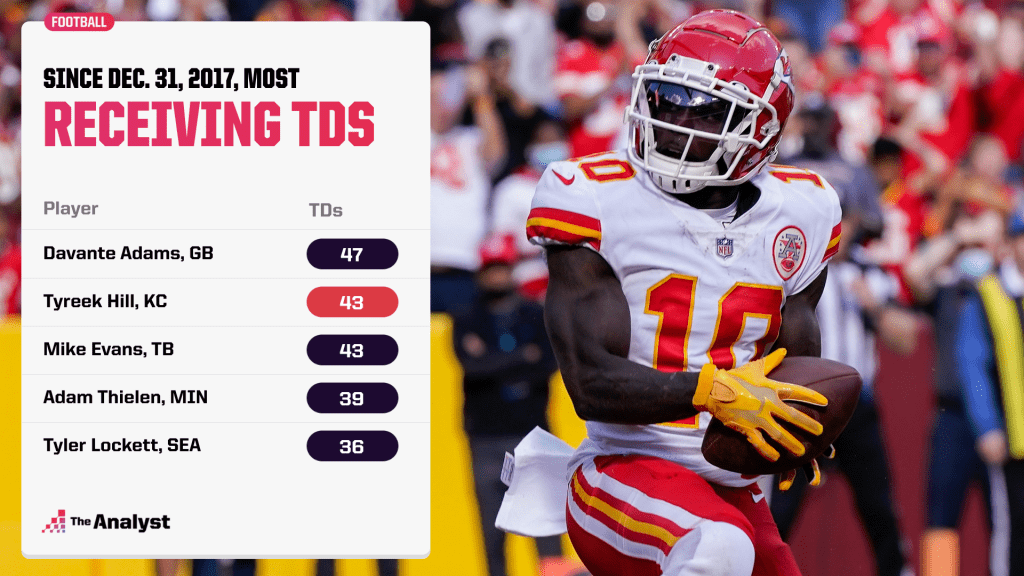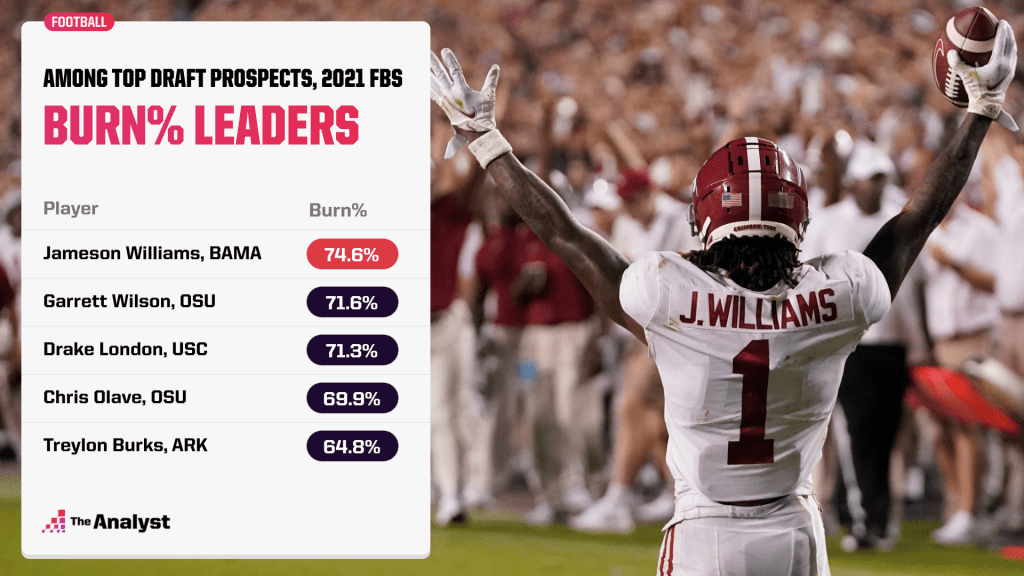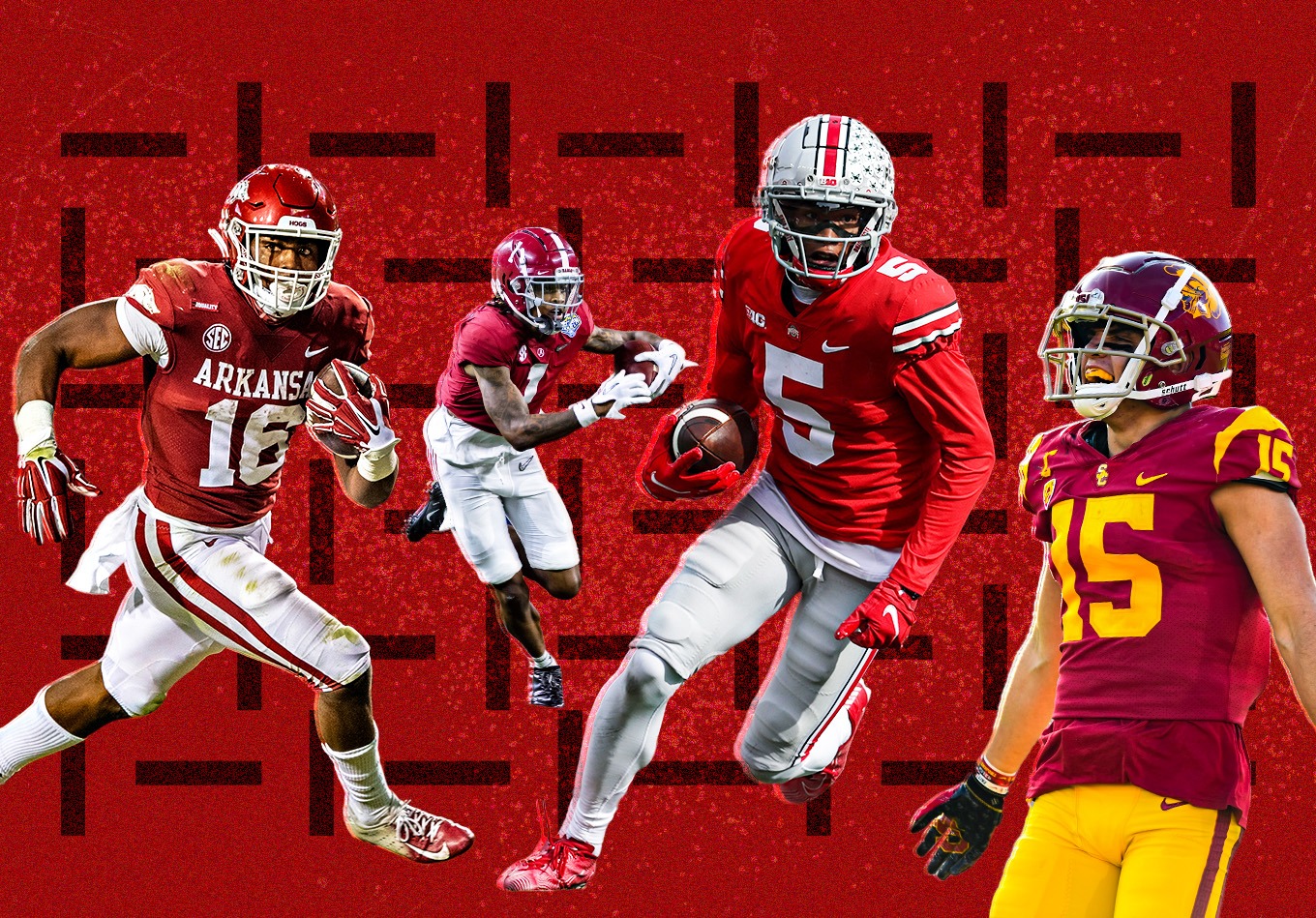Plenty of bad teams have needs at wide receiver, though the Houston Texans and the Atlanta Falcons just need good players at any position.
The Jacksonville Jaguars, the New York Jets and the Chicago Bears are attempting to build around young quarterbacks, perhaps optimistically hoping to follow the example of the Cincinnati Bengals – who took Joe Burrow and the 2021 WR1 Ja’Marr Chase all the way to the Super Bowl.
The 2022 NFL Draft is a little different in that at least two teams with far more realistic title ambitions will be targeting the brightest and best receivers another deep class has to offer.
Both the Green Bay Packers and the Kansas City Chiefs have two first-round picks. And in the case of the Packers, they badly need them.
Aaron Rodgers is back for another year, but Davante Adams is not. Adams – who was stunningly traded to the Las Vegas Raiders, where he was given a lucrative contract – accounted for 30.6% of the Packers’ catches and 34.3% of their receiving yards last season. He leaves a huge hole.
Allen Lazard and Randall Cobb are returning and will have big roles to play, but Marquez Valdes-Scantling – the Packers’ deep-ball option, with the greatest average depth of target in the NFL in consecutive seasons – is also gone.
The Packers are only too aware of what can happen when quarterback Rodgers is not backed in the first round of the draft, so it would be no great surprise to see two leading wideouts head to Green Bay.
The Chiefs are in a similar position, having also traded their dominant receiver and allowed another team – the Miami Dolphins – to pay Tyreek Hill. Only Adams (47) has caught more touchdown passes than Hill (43) since Patrick Mahomes’ debut on New Year’s Eve 2017.

Although Mahomes does have a leading tight end to fall back on in Travis Kelce, the Chiefs’ work so far this offseason – including bringing in Valdes-Scantling – does not quite look to have restored their offense to its former glory. Especially in the highly competitive AFC West that Adams now occupies.
Finding a player like Adams or Hill is a tall order, but the Chiefs, like the Packers, have to try. So, who are the pass catchers under consideration in the first round?
Jameson Williams, Alabama
On pure talent, Williams – who had 79 catches for 1,572 yards and 15 TDs in 2021 – should be gone long before the Packers or the Chiefs are on the clock. But an ACL tear in January might see him fall just a little further.
There is not a statistic that reflects poorly on Williams, although he’s of interest primarily due to the remarkable speed that makes him an elite separator, much like Hill.
At Alabama, the transfer from Ohio State had a burn rate of 74.6%, winning his matchup with a defender on almost three-quarters of his targets and recording 19.3 burn yards per target – both well clear of his fellow first-round candidates, as he was in getting open on 86.0% of targets.

Hill (70.8%) ranked fourth in the NFL last year in burn rate and was open on 82.7% of his targets.
Crucially, heading into the NFL, Williams showed himself to be capable of operating either out wide or in the slot.
Garrett Wilson, Ohio State
Williams left Ohio State having found himself behind two receivers who may go in the first round this year – including Wilson, who is rivalling Williams for WR1 in a number of mock drafts.
Wilson had 70 catches for 1,058 yards and 12 TDs last year and also does not lack for speed, running a 4.38 40-yard dash at the NFL Combine. His calling cards, however, are the lower-body flexibility, foot quickness and route-running savvy that propelled him to 15.1 yards per reception and allowed him to register a burn on 71.6% of his targets.
Of the two Ohio State receivers on this list – we’ll come on to the other – Wilson was less of a deep-ball threat, with his average depth of target 11.3 yards.
That is far from an issue for a team looking for a primary option, however, instead showing the variety that was asked of Adams (9.4 yards) and Hill (10.3 yards) in 2021.
Chris Olave, Ohio State
Olave also shared touches with Wilson last year, even if they were tasked with different roles.
Olave was targeted on just 26.9% of his routes, compared to 30.6 for Wilson, but that was because he often provided the deep threat.
His average depth of target was 14.3 yards in 2021 and had been a huge 18.9 yards in his previous full season in 2019 – third-most among Power 5 receivers. Perhaps he makes more sense for the Packers, who have just lost Valdes-Scantling, than for the Chiefs, who have just signed him.
Either way, this is a role Olave relishes, catching 13 TD passes last season to give him 35 across a four-year college career – the most in Ohio State history. A smooth and, like Wilson, detailed route-runner who tracks the ball extremely well, Olave would likely thrive immediately if paired with Rodgers.
Treylon Burks, Arkansas
If Olave does not fit the bill for either the Packers or the Chiefs, Burks might, for his game is completely different to the man from Ohio State.
Burks’ average depth of target last year was just 9.4 yards as he was regularly deployed out of the backfield by Arkansas, which consistently got the ball in his hands through screen passes and designed hand-offs.
Part of the reason for doing so was the threat Burks poses in the open field. He averaged 9.3 yards after the catch in 2021 – more than Williams’ 9.2.
Burks far outperformed his 8.0 expected yards per target and recorded 14.1 burn yards per target, making excellent use of his combination of physicality and play speed that was not reflected by his 4.55 40-yard dash.
Able to win downfield by relying on his frame and his route-running ability, Burks may possess the most varied skill set of any receiver in the draft with 38 carries across three seasons with the Razorbacks and drawing comparisons to San Francisco 49ers ‘wide back’ Deebo Samuel.
If he can be that sort of player in the NFL, Burks works for the Packers, the Chiefs or just about anybody.
Jahan Dotson, Penn State
While some on this list are worth considering for their physical attributes alone, it’s Dotson’s ball skills that make him stand out.
His catch rating – measured between 0.0 and 1.0 based on how well a receiver successfully catches throws that are considered catchable – was an outstanding 0.978 in 2021. He dropped only a single pass.
Reflecting on an incredible one-handed catch against Ohio State in 2020, the Penn State star said: “I approach that (ball) as a million dollars. It’s a million dollars in the air. If you want it, you go get it.” Dotson will make plenty of money in the NFL if he continues to rein in similar passes.
Dotson was not outstanding at beating defenders (63.8%) or getting open (76.6%) last season, but he still caught 12 TD passes on a Penn State team that struggled amid subpar quarterback play in 2021.
Drake London, USC
Now, the Packers and the Chiefs will not be looking at London as a like-for-like replacement for Adams or Hill.
Finding a comparison for London is not an easy task, as few players are blessed with his blend of size and fluidity as a route runner.
London is 6-foot-4, but just 213 pounds and initially played basketball as well as football at USC. A broken ankle meant he did not run a 40-yard dash at either the NFL Combine or his pro day. However, his speed is not considered to be anything special – not that it matters.
Despite getting open on just 67.2% of his targets in 2021, he had a 71.3% burn percentage, which speaks to the ease with which he can change direction.
“I really don’t have to blow by guys to catch the ball,” he said. “I can, but I don’t have to.”
There were five drops, but London faced a huge number of contested catches and usually came out on top thanks to long arms and considerable wingspan.
He’ll need a quarterback who will trust him to come away with the ball even if he is not open, as was the case last season when he was targeted on a mammoth 42.4% of his routes.
Graphic design by Briggs Clinard.
